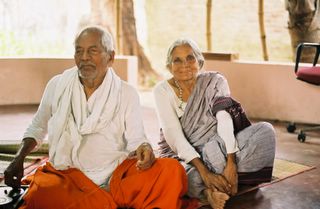Pilgrimage

The traditional Indian version of going to Disneyland is to go on a pilgrimage. Part religious observance, part sight-seeing tour, part social event, and part just plain escape, the pilgrimage has a strong hold on the Indian imagination, as it likely did in among inhabitants of medieval Europe. The difference of course is that the pilgrimage now takes place among the trappings of a civilization bulleting its way into the 21st Century.
There are shoeless pilgrims in dhoti and no shirt, but with cell phones, eating only one meal a day for 40 days as they make their way to the Ayappa shrine in Kerala, checking their e-mail at Internet cafes along the way. Our LAFTI team from Kuthur was unable to get here last evening as they couldn’t rent a van – they were all rented out to pilgrims on their way to the shrine 400 miles away.
The Ayappa shrine is not for a god, but a saint. It seems there was a childless Maharajah of Travancore (the Maharajah of Travancore held central place in my childhood imagination, as my first infatuation with India came from watching Rama and the Jungle on our black-and-white TV set in New York City.) He goes into a jungle and discovers a boy, brings him home, and raises him as his son. His wife is none-to-happy with this state of affairs, and complains she has a headache that can only be cured by tiger’s milk. The son is dispatched to go get some, and rather than bring home the milk, he returns with the whole tiger. Then he vanishes. The Ayappa shrine is where his disappearance is supposed to have taken place.
The Ayappa pilgrimage is a wholly masculine affair. (In theory, young girls or old women could participate, but in practice it is very rare.) After 40 days of travel (they can identify each other by black or dark blue dhotis), the pilgrims arrive in January in the millions, and await the priests’ lighting of a lamp in a cave in a distant mountain that can be seen by all, and is said to bring peace. Then they all go home; how, exactly, I don’t know. All day today, two TV channels have been following the event, mostly watching bare-chested men (sometimes with long beards and wild hair) and boys pushing up against police barriers or the police themselves. Then the light is seen, we get to see it on instant reply. There are fireworks. And it is back to regularly scheduled programming.
Tirupati at Tirumala in Andhra Pradesh is a wholly different kettle of fish. Pilgrimage to Tirupati is a much more gentle affair, takes only a day or two, and can be undertaken at any time. Young boys are brought there for their first haircuts. Marriages or marriage engagements are undertaken there (though pilgrims are told not to bring flowers, or to purchase ‘unauthorized prasadam’ – food offerings made to Lord Venkatesh, a black-faced god-image). There are organized buses to the huge, golden temple complex, and cottages and rooms for rent. Tirupati has its own TV station operating 24 hours a day, with classical music and dance and lectures, with constant advertising about planning one’s trip to the shrine.
Sathya says I should go to a temple. I actually have been to many temples. I reply I am in a temple, which is simply where we are – and it is her house! Having the 19th siddha in it, Krishnammal – the One Who Runs Around - helps. (I must have it translated into Tamil – ah, Krishnammal does it for me - Punida Sutivara – Saint Run-Around.) I can’t seem to pronounce it correctly, but when it is explained to people, they seem to like it.
I can be droll about all of this, but I make no mistake: I am on a pilgrimage every bit as powerful to me as it is to the pilgrims going to Ayappa, and with equivalent spiritual force. And, generally speaking, I have been on mine for an even longer time.


0 Comments:
Post a Comment
<< Home